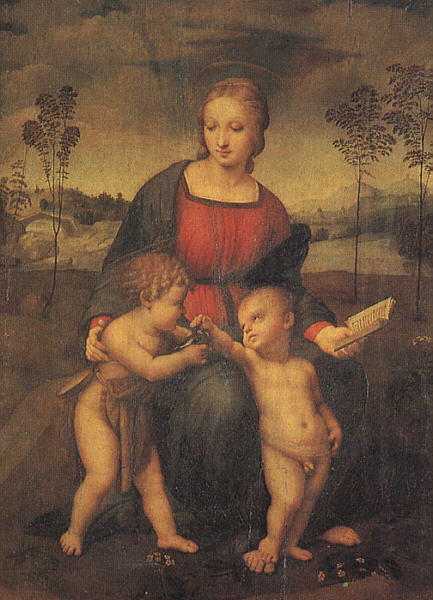
Raphael, or Raffaello Santi as he was born, is considered one of the greatest and most popular artists of all time. He was among the best painters of Renaissance. Raphael was born in Urbino on April 6, 1483. He recieved early training in painting from his father, Giovanni Santi, who was a minor painter. Raphael spent his youth in Urbino, where he was introduced to the works of artists such as Luca Signorelli, Melozzo da Forlí, Francesco di Giorgio, and Paolo Uccello. At the age of seventeen, Raphael's father sent him to Perugia to become a student and assistant of the highly-respectable Perugino. During the four years that he spent in Perugino's workshop, he learned all that his master could teach him without any problems or challenges. Among the independent works that Raphael created at Perugia are two large-scaled paintings, the celebrated Sposalizio,or Marriage of the Virgin and The Crucified Christ with the Virgin Mary, Saints and Angels.
In 1504 Raphael moved to Florence, where he studied the works of artists of the time such as Leonardo da Vinci,Michelangelo, and Fra Bartolommer. He learned their methods of representing the play of light and shade, anatomy, and dramatic action. Raphael's development during the time when he was in Florence can be best traced in his many paintings of Madonnas. Some of these works are Madonna del Granduca, La Belle Jardiniére, Madonna of the Goldfinch and the Madonna del Baldacchino. Raphael's most important commissions during the time when he was in Florence came from Umbria. His most original work of art of this time period was the Entombment of Christ, which was an alterpiece that displays the strong influence of Michelangelo in the anatomical development and postures of the figures.
In 1508 Raphael was called by Pope Julius II to Rome and asked to create frescoes, or paintings on freshly spread moist lime plaster with water-based pigments, in four small rooms of the Vatican Palace. These frescoes are one of Raphael's greatest achievements.
The first of the four rooms is called the Stanza della Segnatura. On the walls of this room are decorations of scenes illustrating elaborate ideas of Theology, Philosophy, Poetry, and Justice. On the wall under Theology is the Disputá, representing a group of people discussing the mystery of the Trinity. The famous fresco The School of Athens, on the wall below Philosophy, displays an open architectural space in which Plato, Aristotle, and other ancient philosophers are engaged in conversation. On the wall beneath Poetry is the distinguished Parnassus, in which Apollo, the Greek god, appears surrounded by the great poets and the Muses, or Greek goddesses of art, poetry, song, and science. The second Vatican chamber, the Stanza d'Eliodoro, which was painted by Raphael and some of his assistants, contains scenes representing the success of the Roman Catholic church over its enemies.
After Pope Julius II died in 1513, Leo X accended as Pope and Raphael's responsibilities increased. He was appointed the chief architect of Saint Peter's Basilica in 1514, and one year later he was made director of all the excavations of ancient times in and near Rome. Only part of the third room of the Vatican Palace, the Stanza del Incendio, was painted by him because of all of his other activities. He only provided the designs for the fourth chamber, the Sala Constantina. Raphael also devised the architecture and decorations of the Chigi Chapel in the Church of Santa Maria del Popolo and the decorations for the Villa Farnesina, which included hisTriumph of Galatea.
In addition to all of these major undertakings, Raphael executed a number of easel paintings, including a portrait of Julius II, a series of Madonnas, and the world-famous Sistine Madonna. Another religious work include the Transfiguration which was finished by one of Raphael's most notable follower, Giulio Romano. Raphael died in Rome on his 37th birthday, April 6, 1520, but he left the world with a lot to remember him by.
Raphael's art still has a great influence on some people today. His art can be seen by many people in different ways. Some people use his art techniques in their own works, while others use it to see what life was like during the Renaissance. Still others see his paintings and express an open environment for creative thinking through what they do.